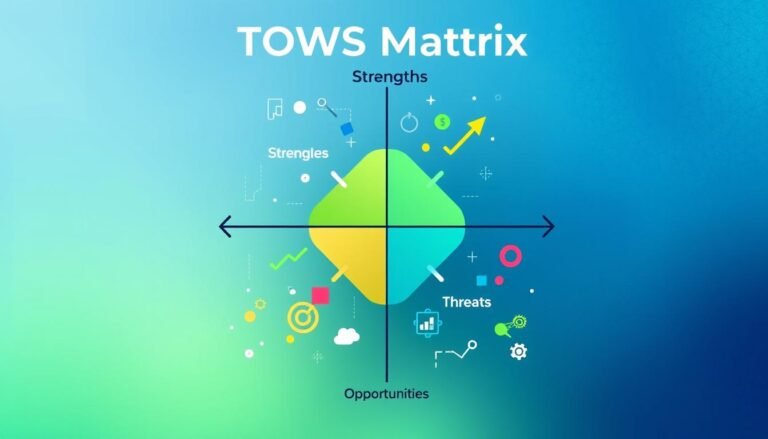Economies of Scale: Unlock Business Growth
Ever wondered why some companies do well while others don’t, even in the same market? The answer often is economies of scale. This idea is key to seeing how companies can grow big by making more and spending less. When companies get bigger, they can share fixed costs over more products. This means they pay less per item and make more money.
In this article, we’ll look into economies of scale and how it helps businesses succeed. We’ll also share ways companies can use this to grow.
Key Takeaways
- Economies of scale can significantly reduce per-unit costs as production increases.
- Operational efficiencies contribute to decreased average variable costs.
- Key sources of economies of scale include bulk purchasing and technological advancements.
- Firms must balance economies of scale with potential diseconomies of scale.
- Larger production levels can enhance profitability, making strategic planning vital.
Understanding Economies of Scale and Its Importance
Economies of scale mean companies save money as they make more products. This helps them do better financially and stay competitive. It’s key to know how making more helps companies grow.
What are Economies of Scale?
Economies of scale happen when making more products lowers the cost per item. Companies spread fixed costs over more products, saving money. They buy more and pay less, helping them compete better.
This idea is crucial for cutting costs and making more products.
Why Economies of Scale Matter for Business Growth
Economies of scale are vital for companies wanting to grow. They can cut costs by 70% to 90% when they make more. Companies like Amazon and Walmart use their size to get better prices and keep profits up.
This lets them offer low prices, draw in customers, and stay profitable.
Types of Economies of Scale: Internal vs. External
There are two kinds of economies of scale: internal and external. Internal ones happen within a company, making it more efficient as it grows. This includes spreading costs and using better technology.
External economies of scale happen across an industry. They come from things like businesses being close together or a skilled workforce in an area. This makes it easier for businesses to grow.
Strategies for Achieving Lower Costs through Increased Production
Businesses always look for ways to cut costs and boost production. They use strategies like improving efficiency, investing in technology, and using expert management. These methods help use resources better, make processes smoother, and cut costs.
Operational Efficiency and Cost Reduction Techniques
Making operations more efficient is key to lowering costs. It means making workflows better, using resources wisely, and improving how things are made. Companies can do things like:
- Bulk purchasing of raw materials to get better prices.
- Streamlining production to cut down on waste and time.
- Automating tasks to reduce labor costs and mistakes.
These steps often lead to big cuts in costs per item, making companies more profitable and productive.
Investment in Technology for Enhanced Production Efficiency
New technology offers big chances for businesses to get better at making things. Companies like Adobe have moved from selling physical products to a cloud-based model. This change lets them update and innovate without spending a lot more. Technology also helps with:
- Data analytics for smarter decisions and better processes.
- Automation tools that make production smoother.
- Cloud computing for flexible solutions.
Putting money into technology boosts efficiency and helps companies reach more customers with less cost.
Leveraging Managerial Expertise for Scale Efficiency
Good management is key to cutting costs and improving efficiency. Leaders can make plans that use resources well. For example:
- Using managers who know the industry helps make better choices.
- Applying methods like Lean or Six Sigma makes things run smoother.
- Creating a culture that always looks for ways to do better encourages teams to find and fix problems.
With strong management, companies can make their production more efficient and stay ahead in the market.
| Strategy | Benefit | Example |
|---|---|---|
| Bulk Purchasing | Lower material costs | Amazon negotiating better prices |
| Process Automation | Reduced labor costs | Robotic process automation in manufacturing |
| Data Analytics | Informed decision-making | Adobe leveraging analytics for product development |
| Lean Management | Waste minimization | Toyota’s production system |
By using these strategies, businesses can cut costs and improve how they work. This helps them grow in a sustainable way.
Examples of Economies of Scale Across Different Industries
Many industries use economies of scale to succeed. By making things in large quantities, companies can cut costs and work more efficiently. This helps them stand out in the market. Let’s look at how this works in manufacturing, retail, and technology.
Manufacturing Sector: Case Study of Toyota
Toyota is a leader in manufacturing thanks to its Toyota Production System (TPS). This system cuts waste and uses resources wisely. By making lots of cars, Toyota lowers the cost of each one and stays profitable.
This shows how big production can make a company more efficient and dominant in the market.
Retail Sector: Insights from Amazon
Amazon is a great example in retail. It buys products in huge amounts to save on shipping and storage. For example, moving 10,000 cartons of milk costs less than moving 100.
This saves money and makes sure customers can get what they need. It’s a smart way to meet demand.
Technology Firms: Economies of Scope in Action
Companies like Apple use economies of scale in tech. They work with suppliers to get better prices and quality. This helps them make more money and invest in new ideas.
They also save money by combining different services and products. This is a big plus of being big and efficient.
| Industry | Example | Benefits of Economies of Scale |
|---|---|---|
| Manufacturing | Toyota | Lower production costs, increased efficiency |
| Retail | Amazon | Cost reduction through bulk buying, enhanced availability |
| Technology | Apple | Improved profit margins via supply chain partnerships |
Benefits of Economies of Scale for Businesses and Consumers
Understanding economies of scale shows big wins for both businesses and consumers. As companies grow, they find ways to cut costs, make better products, and please customers more. These advantages help firms make more money and stand out in the market.
Cost Advantage and Increased Profitability
Bigger companies use their size to cut costs and make more money. By making more products, they spread out their costs over a larger amount. This means they can charge less and still make a profit.
They can use these savings to grow or lower prices for customers. This makes them stronger in the market.
Improved Product Quality and Customer Satisfaction
When companies make more products, they can invest in better quality. This means they can offer top-notch products at good prices. Happy customers stick with the brand, making it even stronger.
This leads to more customers coming in, making the company even more successful.
Competitive Advantage: Staying Ahead in the Market
Companies that use economies of scale have a big edge. They can change quickly and beat the competition. This makes them hard to beat.
They have a strong market presence, are less likely to be taken over, and can get more financing. This helps them keep growing.
| Benefit | Description | Impact on Stakeholders |
|---|---|---|
| Cost Advantage | Reduces per-unit costs through increased production | Lower prices for consumers |
| Profitability | Higher profit margins from cost savings | Reinvestment opportunities for business growth |
| Product Quality | Enhancements enabled by resource allocation | Higher customer satisfaction and loyalty |
| Competitive Advantage | Robust market position and financing access | Better long-term growth prospects |
Conclusion
Economies of scale play a key role in helping businesses grow and work more efficiently. Companies that use these strategies well can see big cost cuts and higher profits. For example, Company ABC lowered its costs from $100 to $75 per unit by buying in bulk.
Case studies from retail and manufacturing show how economies of scale give companies an edge. Companies like Costco become more competitive and profitable by selling in bulk. This shows how being big can lead to saving money.
But, it’s important to know about the downsides, like diseconomies of scale, which can slow growth. Understanding economies of scale helps businesses make better choices. By growing smartly and innovating, companies can use economies of scale to stay ahead in a fast-changing market.
Source Links
- Economies of Scale
- Unlocking Business Growth: Master the Art of Economy of Scale – Amarlo Blog
- Economies of Scale: Understanding How Bigger Can Be Better
- What Are Economies of Scale?
- What is Economies Of Scale? Definition of Economies Of Scale, Economies Of Scale Meaning – The Economic Times
- How To Leverage Economies of Scale To Grow Your Business
- What Is Economies of Scale? How It Works | Airhouse Glossary
- Reducing Costs And Increasing Profits With Economies Of Scale And Offshoring
- Economies of scale examples – Economics Help
- Economies of Scale
- Economies of Scale: What Are They and How Are They Used?
- The Advantages & Benefits of Economies of Scale
- Economies of Scale Explained: Benefits and Industry Examples | Roadmunk
- Economies of scale
- Economies of Scope vs. Economies of Scale: What’s the Difference?
- The Advantages & Benefits of Economies of Scale







